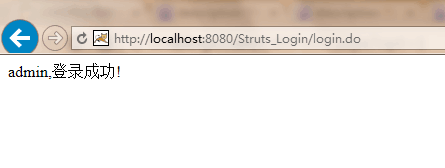前言:本篇文章是本人这周学习的一个小结,在自我总结的同时,希望也能够给其他同学带来一点帮助。本文主要知识是参照书本上的知识点以及网上其他博客文章,在上机操练后的所得,具体源码主要来自http://blog.csdn.net/lovesummerforever/article/details/17348871。
本文主要包括以下三点:MVC设计模式基本概念、Struts工作原理、使用Struts框架实现用户登陆具体实例操作。
一、 MVC设计模式
在了解MVC模式之前,先要弄清楚什么是设计模式。
设计模式是一套被反复使用、多数人知晓的、代码设计经验的总结,模式必须是典型问题的解决方案。设计模式的作用是解决一类问题的成功经验,是为了可重用代码、让代码更容易被他人理解、保证代码的可靠性。
MVC是一种流行的软件设计模式,这种模式将应用程序实现分为模型(Model)、视图(View)和控制器(Controller)三个部分,主要特点是把显示和数据分离,增加了软件的可重用性。MVC设计模式具体如图一:
图一:MVC设计模式
1、 模型(Model)
模型表示数据和业务处理,它可以分为数据模型和业务模型,分别代表应用程序的状态和业务逻辑。模型对应的组件是JavaBean或者Java类,只需写一次就可以被多个视图重用,减少了代码的重复性。用一句话来说:模型就是实现系统中的具体功能模块。
2、 视图(View)
视图是用户看到的与之交互的界面,负责数据采集和处理用户的请求。视图只是作为一种输出数据并允许用户操纵的方式,对应的组件是JSP或HTML文件。
3、 控制器(Controller)
控制器是接受用户端的请求,将模型和视图联系在一起,实现用户请求的功能。对应的组件是Servlet,起承上启下的枢纽作用。
二、 Struts工作原理
Struts是第一个按照MVC设计模式搭建的Web开发框架,基于Struts开发的应用由三类组件构成:控制器组件、模型组件和视图组件。具体模型如图二:
图二:Struts结构图
1、 控制器组件
控制器组件包括ActionServlet(核心控制器)和自定义的Action(代表一个用户的操作)。ActionServlet的只要功能是将一个客户端的请求映射到相应的Action,如果该Action配置了指定的ActionForm,那么就在request中抓取数据填充到这个ActionForm,然后调用Action的execute方法。在execute方法执行完成后,ActionServlet将接受包括有下一个资源信息的ActionFoward对象,并将请求转至下一个资源。
2、 视图组件
视图组件包括JSP页面、ActionForm和Struts标签。视图组件一般由JSP实现,还包括自定义的ActionForm类和Struts标签。自定义的ActionForm类用于封装页面提交的数据,且ActionForm类需要在struts-config.xml中配置,从页面获得输入属性与表单域name属性值一致。
3、 模型组件
模型组件包括定义和实现业务逻辑的接口和类。模型组件并不由Struts提供,由普通的接口和JavaBean充当,需要用户自己编码实现。例如,用户登陆时获取用户名和密码并与数据库中数值比较的接口等。
三、 使用Struts框架实现用户登陆具体实例操作
1、 创建Web项目,添加Struts到项目
首先创建一个Web项目,输入项目名Struts_Login后,选择MyEclipse工具中的MyEclipse菜单中的Project Capabilities->Add Struts Capabilities命令,具体如图三:
图三:添加Struts框架Jar包到项目
在添加完Struts框架jar包文件后,系统为自动产生struts-config.xml文件,并在web.xml中自动添加ActionServlet。
2、 实现登陆功能的ActionForm类和Action类编写
ActionForm主要用来封装页面输入的表单信息,本例中只设置了用户名和密码两个信息,具体类名是LoginActionForm。代码如下:
package com.liu.struts; import org.apache.struts.action.ActionForm; public class LoginActionForm extends ActionForm { /** * */ private static final long serialVersionUID = 1L; //用户名。 private String username; //密码。 private String password; //设置密码。 public void setPassword(String password) { this.password = password; } //得到用户名。 public String getUsername() { return username; } //设置用户名。 public void setUsername(String username) { this.username = username; } //得到密码。 public String getPassword() { return password; } }
Action类主要是用来实现具体用户操作的功能,本例中LoginAction类继承Action,表示用户的登陆操作。具体代码如下:
package com.liu.struts; import javax.servlet.http.HttpServletRequest; import javax.servlet.http.HttpServletResponse; import org.apache.struts.action.Action; import org.apache.struts.action.ActionForm; import org.apache.struts.action.ActionForward; import org.apache.struts.action.ActionMapping; public class LoginAction extends Action{ public ActionForward execute(ActionMapping mapping,ActionForm form, HttpServletRequest request, HttpServletResponse response) throws Exception { LoginActionForm laf = (LoginActionForm)form; String username = laf.getUsername(); String password = laf.getPassword(); UserManager userManager = new UserManager(); //传递用户名和密码 try { userManager.login(username, password); request.setAttribute("username", username); return mapping.findForward("success"); }catch(UserNotFoundException e) { e.printStackTrace(); request.setAttribute("msg","用户不能找到,用户名称=[" +username +"+]"); }catch(PasswordErrorException e) { e.printStackTrace(); request.setAttribute("msg","密码错误"); } return mapping.findForward("error"); } }
3、 处理用户登陆的业务逻辑层userManager类的书写
本例中用户登陆成功的用户名和密码均为admin,是直接写在.java文件中的信息,没有与数据库中信息进行验证交互,但弄清楚本例后,自己再去进行数据库中信息验证,具体步骤操作也是大同小异。
userManager类具体源码如下:
package com.liu.struts; public class UserManager { public void login(String username,String password) { if(!"admin".equals(username)) { throw new UserNotFoundException(); } if(!"admin".equals(password)) { throw new PasswordErrorException(); } } }
UserNotFoundException具体代码如下:
package com.liu.struts; public class UserNotFoundException extends RuntimeException { /** * */ private static final long serialVersionUID = 1L; public UserNotFoundException() { } public UserNotFoundException(String message) { super(message); } public UserNotFoundException(Throwable cause) { super(cause); } public UserNotFoundException(String message,Throwable cause) { super(message, cause); } }
PasswordErrorException具体代码如下:
package com.liu.struts; public class PasswordErrorException extends RuntimeException { /** * */ private static final long serialVersionUID = 1L; public PasswordErrorException() { } public PasswordErrorException(String message) { super(message); } public PasswordErrorException(Throwable cause) { super(cause); } public PasswordErrorException(String message,Throwable cause) { super(message, cause); } }
以上便是业务逻辑层处理用户登陆的具体代码。
4、 配置sturts-config文件
具体Struts-config代码如下:
xml version="1.0" encoding="UTF-8"?>
DOCTYPE struts-config PUBLIC "-//Apache Software Foundation//DTD Struts Configuration 1.3//EN" "http://struts.apache.org/dtds/struts-config_1_3.dtd">
<struts-config>
<form-beans>
<form-bean name="loginForm" type="com.liu.struts.LoginActionForm"/>
form-beans>
<global-exceptions />
<global-forwards />
<action-mappings>
<action path="/login"
type="com.liu.struts.LoginAction"
name="loginForm"
scope="request"
>
<forward name="success" path="/Login_success.jsp"/>
<forward name="error" path="/Login_error.jsp"/>
action>
action-mappings>
<message-resources parameter="com.yourcompany.struts.ApplicationResources" />
struts-config>
与是相关的Web.xml代码如下(此处用的系统自动导入Struts的jar包文件,所以web.xml不需要配置,不过可以参考看一下):
xml version="1.0" encoding="UTF-8"?>
<web-app xmlns="http://java.sun.com/xml/ns/javaee" xmlns:xsi="http://www.w3.org/2001/XMLSchema-instance" version="3.0" xsi:schemaLocation="http://java.sun.com/xml/ns/javaee http://java.sun.com/xml/ns/javaee/web-app_3_0.xsd">
<display-name />
<servlet>
<servlet-name>actionservlet-name>
<servlet-class>org.apache.struts.action.ActionServletservlet-class>
<init-param>
<param-name>configparam-name>
<param-value>/WEB-INF/struts-config.xmlparam-value>
init-param>
<init-param>
<param-name>debugparam-name>
<param-value>3param-value>
init-param>
<init-param>
<param-name>detailparam-name>
<param-value>3param-value>
init-param>
<load-on-startup>0load-on-startup>
servlet>
<servlet-mapping>
<servlet-name>actionservlet-name>
<url-pattern>*.dourl-pattern>
servlet-mapping>
<welcome-file-list>
<welcome-file>index.jspwelcome-file>
welcome-file-list>
web-app>
6、 编写视图层JSP文件
index.jsp源码如下(此JSP文件为登陆界面):
<%@ page language="java" import="java.util.*" pageEncoding="UTF-8"%> <% String path = request.getContextPath(); String basePath = request.getScheme()+"://"+request.getServerName()+":"+request.getServerPort()+path+"/"; %> DOCTYPE HTML PUBLIC "-//W3C//DTD HTML 4.01 Transitional//EN"> <html> <head> <base href="<%=basePath%>"> <title>My JSP 'index.jsp' starting pagetitle> <meta http-equiv="pragma" content="no-cache"> <meta http-equiv="cache-control" content="no-cache"> <meta http-equiv="expires" content="0"> <meta http-equiv="keywords" content="keyword1,keyword2,keyword3"> <meta http-equiv="description" content="This is my page"> head> <body> <form action="login.do" method="post"> 用户:<input type="text" name="username"><br> 密码:<input type="password" name="password"><br> <input type="submit" value="登录"> form> body> html>
当用户密码或用户名输入错误时,跳转到Login_error.jsp界面,具体源码如下:
<%@ page language="java" import="java.util.*" pageEncoding="UTF-8"%> <% String path = request.getContextPath(); String basePath = request.getScheme()+"://"+request.getServerName()+":"+request.getServerPort()+path+"/"; %> DOCTYPE HTML PUBLIC "-//W3C//DTD HTML 4.01 Transitional//EN"> <html> <head> <base href="<%=basePath%>"> <title>My JSP 'Login_error.jsp' starting pagetitle> <meta http-equiv="pragma" content="no-cache"> <meta http-equiv="cache-control" content="no-cache"> <meta http-equiv="expires" content="0"> <meta http-equiv="keywords" content="keyword1,keyword2,keyword3"> <meta http-equiv="description" content="This is my page"> head> <body> <%-- <%=request.getAttribute("msg") %> --%> ${msg },登陆错误!!! body> html>
当用输入用户名和密码均正确时,跳转到Login_success.jsp界面,具体源码如下:
<%@ page language="java" import="java.util.*" pageEncoding="UTF-8"%> <% String path = request.getContextPath(); String basePath = request.getScheme()+"://"+request.getServerName()+":"+request.getServerPort()+path+"/"; %> DOCTYPE HTML PUBLIC "-//W3C//DTD HTML 4.01 Transitional//EN"> <html> <head> <base href="<%=basePath%>"> <title>My JSP 'Login_success.jsp' starting pagetitle> <meta http-equiv="pragma" content="no-cache"> <meta http-equiv="cache-control" content="no-cache"> <meta http-equiv="expires" content="0"> <meta http-equiv="keywords" content="keyword1,keyword2,keyword3"> <meta http-equiv="description" content="This is my page"> head> <body> ${username},登录成功! body> html>
附:下图四是项目Struts_Login目录结构,如下:
图四:Struts_Login项目目录结构
6、部署、运行项目
首先开启Tomcat服务,然后给Struts_Login项目配置具体Tomcat,完成这两步后,在浏览器中输入http://localhost:8080/Struts_Login即可得到预期目标。具体步骤截图及运行截图如下:
图五:打开Tomcat服务
图六:给Struts_Login配置Tomcat
图七:登陆界面
图八:登陆成功界面
图九:登陆失败界面
好了,以上就是使用Struts框架,实现用户登陆功能的具体步骤,写了两个小时终于把本文写完了~








